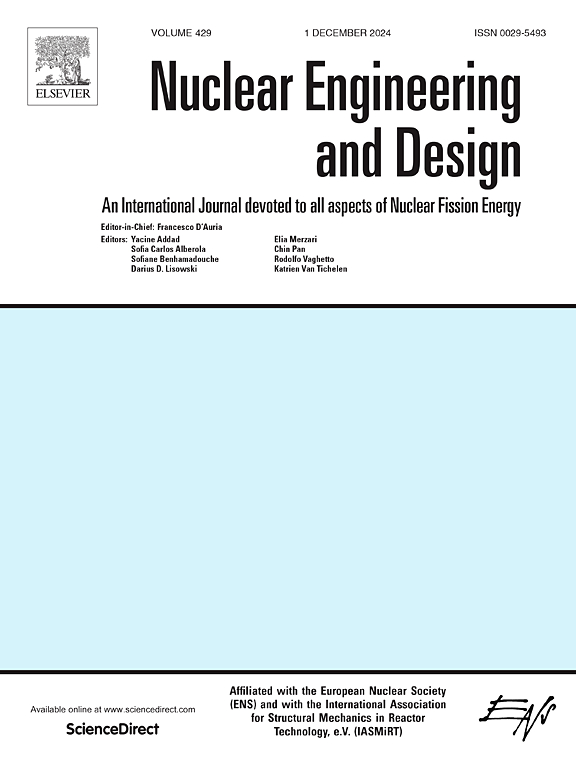Neutronic design and analysis of the accident-tolerant fuel (ATF) application to VVER-1000 nuclear reactor as well as evaluation of dynamic parameters
IF 1.9
3区 工程技术
Q1 NUCLEAR SCIENCE & TECHNOLOGY
引用次数: 0
Abstract
In order to improve the safety of commercial nuclear reactors, this paper presents neutronic design and analysis of the accident-tolerant fuels (ATF) application to VVER-1000 nuclear reactor. The study commences by simulating a fuel assembly containing 2.4% enriched uranium.
The simulation of a VVER-1000 reactor core loaded with standard uranium dioxide (UO2) fuel was then conducted using the MCNPX 2.6 code. This simulation yielded various neutronic and dynamic parameters, including the multiplication factor, excess reactivity, delayed neutron fraction, fuel and coolant temperature reactivity feedbacks, power peaking factor, and fuel burn-up. These values were subsequently compared with existing reference data.
Finally, the reactor core was simulated using accident-tolerant fuel. The resulting data was analyzed to identify the optimal combination of fuel and cladding. Throughout the study, the MCNPX 2.6 software was employed for neutronic core analysis. Comparative analysis revealed that uranium carbide (UC) offers superior safety margins in both neutronic and dynamic aspects, outperforming uranium dioxide (UO2) and uranium mononitride (UN).
Simulations exploring the use of silicon carbide (SiC) and FeCrAl as alternative cladding materials within the reactor core demonstrated potential advantages over traditional Zirconium (Zr). Results indicate that application of ATF can improve cycle length, temperature reactivity feedbacks and power peaking factor compare to the reference core (UO2 + Zr), significantly.
求助全文
约1分钟内获得全文
求助全文
来源期刊

Nuclear Engineering and Design
工程技术-核科学技术
CiteScore
3.40
自引率
11.80%
发文量
377
审稿时长
5 months
期刊介绍:
Nuclear Engineering and Design covers the wide range of disciplines involved in the engineering, design, safety and construction of nuclear fission reactors. The Editors welcome papers both on applied and innovative aspects and developments in nuclear science and technology.
Fundamentals of Reactor Design include:
• Thermal-Hydraulics and Core Physics
• Safety Analysis, Risk Assessment (PSA)
• Structural and Mechanical Engineering
• Materials Science
• Fuel Behavior and Design
• Structural Plant Design
• Engineering of Reactor Components
• Experiments
Aspects beyond fundamentals of Reactor Design covered:
• Accident Mitigation Measures
• Reactor Control Systems
• Licensing Issues
• Safeguard Engineering
• Economy of Plants
• Reprocessing / Waste Disposal
• Applications of Nuclear Energy
• Maintenance
• Decommissioning
Papers on new reactor ideas and developments (Generation IV reactors) such as inherently safe modular HTRs, High Performance LWRs/HWRs and LMFBs/GFR will be considered; Actinide Burners, Accelerator Driven Systems, Energy Amplifiers and other special designs of power and research reactors and their applications are also encouraged.
 求助内容:
求助内容: 应助结果提醒方式:
应助结果提醒方式:


